Behaviour
All pigs should be allowed to express natural behaviours. Behaviour refers to the way that an animal acts. An important type of behaviour that an animal expresses are those that are instinctive (what they would typically do in the wild). Enough space, proper shelter and housing, as well as company of the animal's own kind, encourages the expression of natural behaviours.
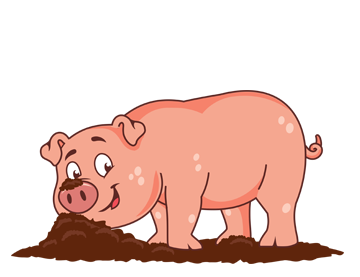
Did you know that there is a special law protecting animals?
This law is called the Animal Welfare Act. The Animal Welfare Act outlines how people must take care of and act towards animals in New Zealand. The Ministry for Primary Industries (MPI), the Police and SPCA work together to make sure people in New Zealand follow these laws.
Under the Animal Welfare Act, all animal guardians (owners) are responsible for making sure the welfare needs of animals in their care are met. Learning about the Five Domains helps us to understand these welfare needs and how we can make sure we provide these. One of the Five Domains is Behaviour. In this section you will learn about this domain and how you can make sure your pigs receive the exercise and enrichment they need to express their natural behaviours.



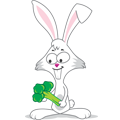









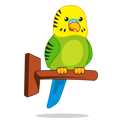



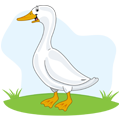

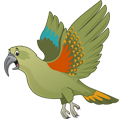

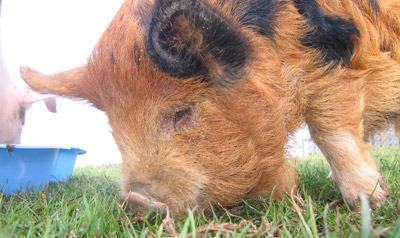 Foraging is a natural behaviour that involves an animal searching for and eating food. In the wild, a large part of a pig’s day can be spent foraging for food.
Foraging is a natural behaviour that involves an animal searching for and eating food. In the wild, a large part of a pig’s day can be spent foraging for food.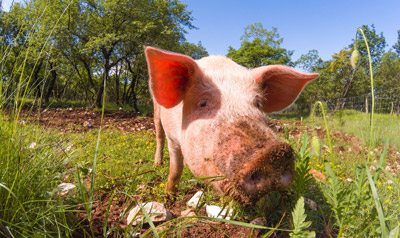 Rooting is one of those very important behaviours for pigs. In the wild, pigs can spend up to 40% of their day rooting around in the ground, foraging for food using their very strong noses.
Rooting is one of those very important behaviours for pigs. In the wild, pigs can spend up to 40% of their day rooting around in the ground, foraging for food using their very strong noses.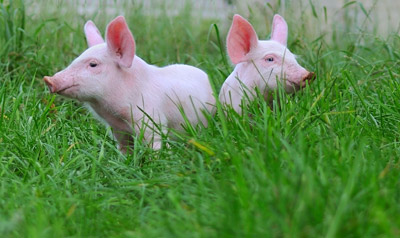 Pigs are social animals, meaning they like to be in the company of other pigs. Pigs are happier in pairs or small groups, so if you are able, it is preferable to have another pig so that they keep each other company. Pigs have strong social needs and although they will bond with people, it doesn’t replace the fact that another pig usually makes the best companions.
Pigs are social animals, meaning they like to be in the company of other pigs. Pigs are happier in pairs or small groups, so if you are able, it is preferable to have another pig so that they keep each other company. Pigs have strong social needs and although they will bond with people, it doesn’t replace the fact that another pig usually makes the best companions. Sows (female pigs that have had babies) and gilts (female pigs that have not had babies) have a natural instinct to make nests. This desire is particularly strong in pregnant sows prior to giving birth to their piglets. However, even pigs who are not pregnant feel the need to create a comfortable, nested sleeping area.
Sows (female pigs that have had babies) and gilts (female pigs that have not had babies) have a natural instinct to make nests. This desire is particularly strong in pregnant sows prior to giving birth to their piglets. However, even pigs who are not pregnant feel the need to create a comfortable, nested sleeping area. Pigs have a range of different communication techniques that you can learn to identify. They are very vocal and communicate in grunts, squealing and snorting. Research has shown that pigs make at least 20 different sounds, which all mean different things.
Pigs have a range of different communication techniques that you can learn to identify. They are very vocal and communicate in grunts, squealing and snorting. Research has shown that pigs make at least 20 different sounds, which all mean different things.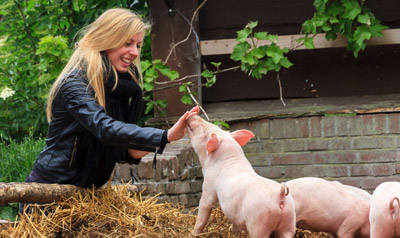 As mentioned above, pigs are extremely smart animals. They love to learn new things and are very capable of learning a range of behaviours and understanding human words and sentences. By training your pig, not only are you stimulating your pig's mind and keeping them busy and entertained, you will also be bonding with your pig more closely and building a relationship built on trust.
As mentioned above, pigs are extremely smart animals. They love to learn new things and are very capable of learning a range of behaviours and understanding human words and sentences. By training your pig, not only are you stimulating your pig's mind and keeping them busy and entertained, you will also be bonding with your pig more closely and building a relationship built on trust. Pigs are incredibly smart and sensitive animals. They love to be kept busy and challenged, so they require both physical and mental stimulation to keep them happy and healthy. Your pig will need enrichment items, activities, as well as lots of attention and affection. Keeping a pig without companionship or enrichment is likely to lead to a bored, agitated or destructive pig.
Pigs are incredibly smart and sensitive animals. They love to be kept busy and challenged, so they require both physical and mental stimulation to keep them happy and healthy. Your pig will need enrichment items, activities, as well as lots of attention and affection. Keeping a pig without companionship or enrichment is likely to lead to a bored, agitated or destructive pig..png)









